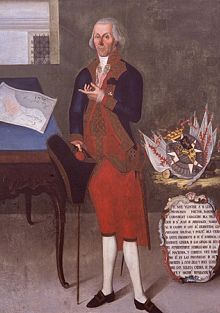Francisco Luis Héctor de Carondelet
The Baron of Carondelet | |
|---|---|
 Portrait by unknown artist | |
| 2nd Spanish Governor of San Salvador | |
| In office 1789–1791 | |
| Monarch | Charles IV |
| Preceded by | José Ortiz de la Peña |
| Succeeded by | José Antonio María de Aguilar |
| 7th Spanish Governor of Louisiana | |
| In office 1791–1797 | |
| Monarch | Charles IV |
| Preceded by | Esteban Rodríguez Miró |
| Succeeded by | Manuel Gayoso de Lemos |
| 27th President of the Real Audiencia of Quito | |
| In office 1799–1807 | |
| Monarch | Charles IV |
| Preceded by | Luis Antonio de Guzmán |
| Succeeded by | Manuel Ruiz Urriés de Castilla |
| Personal details | |
| Born | Francisco Luis Héctor de Carondelet y Bosoist July 29, 1748 Cathedral of Quito |
| Spouse | Maria Concepción Castaños y Aragorri |
| Parent(s) | Jean Louis de Carondelet and Marie Angélique Bernarde de Rasoir |
| Military service | |
| Allegiance | |
| Branch/service | Spanish Army |
| Battles/wars | American Revolutionary War |
Francisco Luis Héctor de Carondelet y Bosoist, 5th Baron of Carondelet, (born 1748,
Biography
Youth and military career
Carondelet entered the service of the King of Spain in 1762, at age fifteen. By 1781, he commanded the IV Division, which fought at the
Governor of El Salvador (1789 – 1791)
Carondelet was named governor of El Salvador in 1789. Because the local indigenous population working in the indigo industry had declined greatly, Carondolet recruited Spanish laborers. Their descendants are among the blonde and fair-skinned people of today's Chalatenango Department.[3]
Governor of Louisiana (1791 – 1797)
After his term as governor of El Salvador ended he was appointed governor of the Spanish colonies of Louisiana and West Florida, from 1791 to 1797. As French was his mother tongue, he was well regarded by the French Creole population. He established Louisiana's first newspaper, Le Moniteur. He made many improvements in the infrastructure of New Orleans, including the Carondelet Canal and the city's first street lighting. The street light tenders (attendants) served as watchmen and de facto municipal police.[4]
About 1793, he granted land near Cape Girardeau, Missouri, to the Black Bob Band of Hathawekela Shawnee.[5]
U.S. expansion
Carondelet became concerned about westward U.S. expansion and was involved in the West Florida Controversy, which concerned the border between West Florida and the United States. He wanted to thwart the American policy of trying to secure unchallenged access to the Mississippi River, a goal which made Spanish colonial officials fear for the independence of Louisiana and New Spain. Working through an alliance with Native American tribes, Carondelet succeeded in thwarting westward American expansion for several years.
However, the U.S. finally gained ratification (1795) of
Slave code
Upon taking up his post he had to deal with the
This initiative created a certain amount of tension between him and the slaveholders. Carondelet responded by developing a stronger relationship with the slave and free-colored populations. He commissioned 29 free men of color in the militia and was proud of the three companies he formed with soldiers of African descent.[3]
President of the Real Audiencia de Quito (Ecuador) (1799 – 1807)
After his term in Louisiana, Carondelet served as President of the
In 1803, Indian insurrections took place in
Namesakes in North and South America
- The Carondelet Canal in New Orleans was constructed on his orders and named for him. (It was filled in during the 1930s, with its turning basin the origin for the name of Basin Street.)
- Carondelet Street in New Orleans
- Carondelet Farm in San Diego, California, named after the New Orleans Street
- Carondelet Street in Mandeville, Louisiana
- Carondelet, a neighborhood in St. Louis, Missouri
- Carondelet Drive in Kansas City, MO (named for the St. Joseph Medical Center (Kansas City, Missouri), originally founded by Sisters of St. Joseph of Carondelet from St. Louis, Missouri)
- Fort Carondelet, a fort located on the Osage River in Vernon County, Missouri
- Carondelet Presidential Palace in Quito, Ecuador
- Carondelet Street in Dallas, TX. No longer exists. When the railroads entered Dallas after 1872, trackage rights in lower North Dallas affected several pioneer streets. Carondelet was chopped off and closed on its way to the river bank to permit the Missouri-Kansas-Texas Railroad to build yards and station facilities. The stub end of the street from Market eastward then lost its name when it became a part of Ross Avenue.
References
- ^ ISBN 978-0-19-520635-7.
- ^ a b c Rodolfo Pérez Pimentel. "LUIS HÉCTOR GUISLAIN DE CARONDELET Y BARÓN DE CARONDELET". www.diccionariobiograficoecuador.com. Archived from the original on 2011-10-10. Retrieved 2013-02-18.
- ^ a b c "François Louis Hector de Carondelet". Noyelles sur Selle, Carondelet (in French). Retrieved 2013-02-18.
- ISBN 9780674059870.
- ^ "Hathawekela Indian Tribe History". Access Genealogy. 2013. Retrieved 2013-02-17.
External links
- Carondelet's Administration, 1792 to 1797 (Vol. III, Chapter 6 of Gayarré's History of Louisiana)


